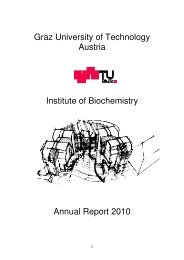Staff Members of the Institute of Biochemistry, TU Graz http://www ...
Staff Members of the Institute of Biochemistry, TU Graz http://www ...
Staff Members of the Institute of Biochemistry, TU Graz http://www ...
You also want an ePaper? Increase the reach of your titles
YUMPU automatically turns print PDFs into web optimized ePapers that Google loves.
iosyn<strong>the</strong>sis in a type <strong>of</strong> feedback regulation. Conclusively, SE storage and mobilization<br />
although being dispensable for yeast viability under laboratory conditions contribute<br />
markedly to sterol homeostasis in this microorganism.<br />
Previous work from our laboratory had demonstrated that deletion <strong>of</strong> TGL3, <strong>the</strong><br />
major yeast TAG lipase located to lipid particles, resulted in a decreased mobilization <strong>of</strong><br />
triacylglycerols (TAG) from <strong>the</strong> lipid particles. TAG stored in a tgl3 mutant contained<br />
slightly increased amounts <strong>of</strong> C22:0 and C26:0 very long chain fatty acids (VLCFAs).<br />
These VLCFAs are indispensable for sphingolipid biosyn<strong>the</strong>sis and crucial for raft<br />
association in <strong>the</strong> yeast. To understand <strong>the</strong> possible role <strong>of</strong> TAG lipolysis in<br />
sphingolipid metabolism, we carried out radiolabeling experiments with sphingolipid<br />
precursors in wild type and tgl mutants. These results indicated that <strong>the</strong> mutants have a<br />
significantly reduced rate <strong>of</strong> sphingolipid biosyn<strong>the</strong>sis and an increased rate <strong>of</strong> turnover<br />
compared to wild type. Competition experiments with labeled palmitic acid (C16:0) and<br />
non-radiolabeled cerotic acid (C26:0) demonstrated that <strong>the</strong> C26:0 fatty acid competed<br />
with C16:0 fatty acid labeling <strong>of</strong> sphingolipids. Thus, we hypo<strong>the</strong>size that stored TAG<br />
can be a fatty acid donor for sphingolipid formation and TAG lipases contribute to this<br />
pathway <strong>of</strong> <strong>the</strong> yeast.<br />
Ano<strong>the</strong>r aspect addressed in our laboratory is characterization <strong>of</strong> yeast TAG<br />
lipases with special emphasis on <strong>the</strong> topology <strong>of</strong> <strong>the</strong>se proteins on <strong>the</strong> surface <strong>of</strong> lipid<br />
particles where <strong>the</strong>se proteins occur. This study is paralleled by topology studies <strong>of</strong><br />
o<strong>the</strong>r proteins located to <strong>the</strong> lipid particle surface, especially Erg1p, a squalene<br />
epoxidase, which has been studied in our laboratory before. Preliminary studies<br />
addressing accumulation <strong>of</strong> squalene in <strong>the</strong> yeast under certain conditions revealed that<br />
this component is localized to different subcellular sites depending on <strong>the</strong> cell biological<br />
and metabolic status <strong>of</strong> <strong>the</strong> yeast.<br />
Characterization <strong>of</strong> organelles from <strong>the</strong> yeast Pichia pastoris<br />
The yeast Pichia pastoris is an important experimental system for heterologous<br />
expression <strong>of</strong> proteins. Never<strong>the</strong>less, surprisingly little is known about organelles <strong>of</strong> this<br />
microorganism. For this reason, we started a systematic biochemical and cell biological<br />
study to establish standardized methods <strong>of</strong> Pichia pastoris organelle isolation and<br />
characterization. The expertise <strong>of</strong> our laboratory in cell fractionation and organelle<br />
isolation from <strong>the</strong> yeast Saccharomyces cerevisiae has been developed through a<br />
number <strong>of</strong> investigations in <strong>the</strong> past. Some <strong>of</strong> <strong>the</strong> methods applied for Saccharomyces<br />
cerevisiae can be used for Pichia pastoris cell fractionation, whereas o<strong>the</strong>rs cannot or<br />
need to be adapted.<br />
Recent work focused on <strong>the</strong> biochemical characterization <strong>of</strong> mitochondrial<br />
membranes from Pichia pastoris grown on different carbon sources (Figure 4). The<br />
major aims <strong>of</strong> this project were (1) qualitative and quantitative analysis <strong>of</strong><br />
phospholipids, fatty acids and sterols from mitochondrial membranes; and (2) analysis<br />
<strong>of</strong> mitochondrial subfractions from Pichia pastoris grown on different carbon sources.<br />
More recently, experiments were started to study selected lipid syn<strong>the</strong>sizing enzymes<br />
from Pichia pastoris with emphasis on <strong>the</strong> phosphatidylethanolamine biosyn<strong>the</strong>tic<br />
machinery. Preliminary data are a first step towards <strong>the</strong> understanding <strong>of</strong> <strong>the</strong> Pichia<br />
pastoris lipidome which will provide initial insight into <strong>the</strong> variety <strong>of</strong> membrane<br />
components <strong>of</strong> this yeast.<br />
19














